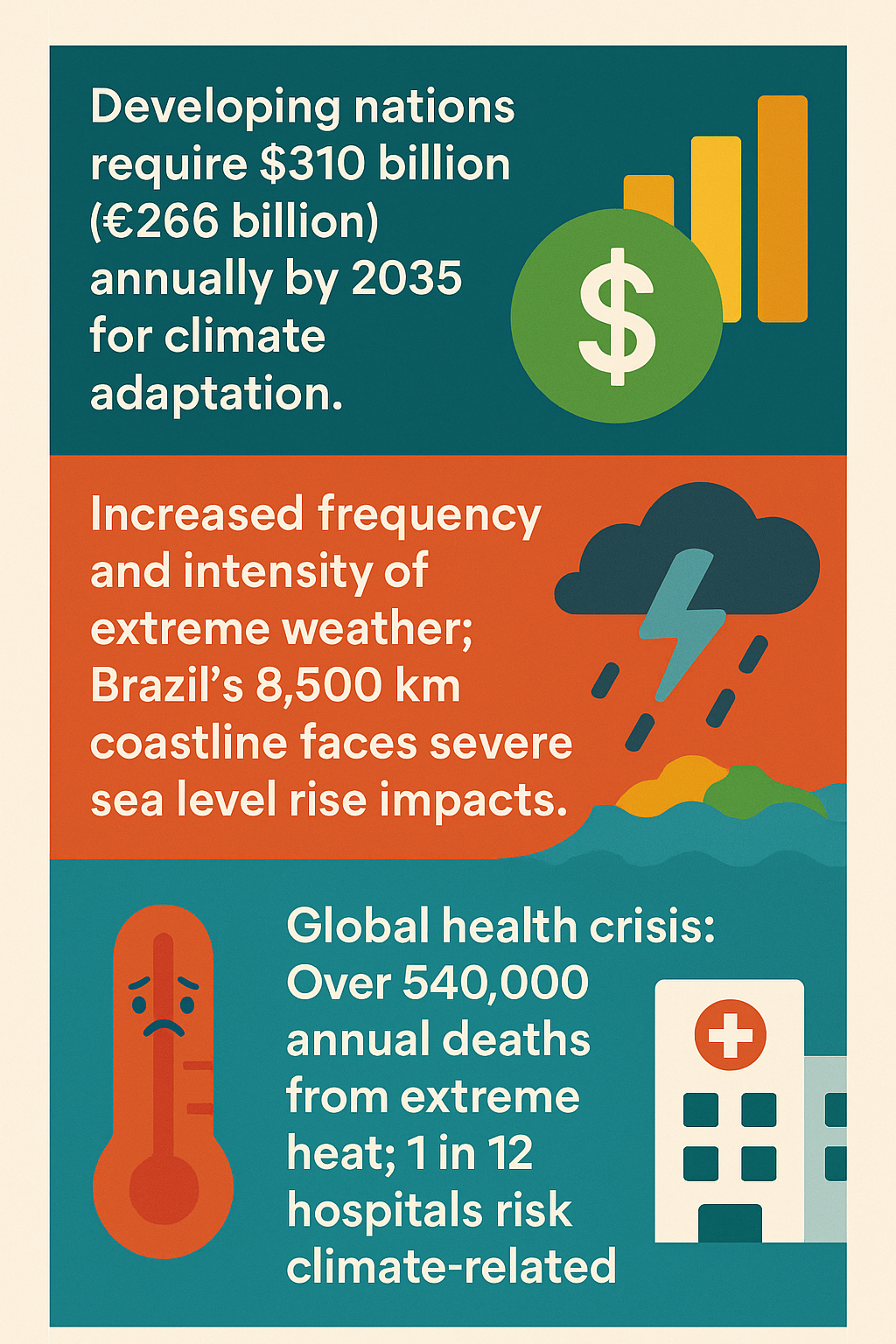Global Scans · Climate Change & Extreme weather · Signal Scanner
Accelerating Climate-Driven Hydrological Stress: An Emerging Disruptor for Global Stability
The planet’s freshwater systems face intensifying pressures as climate change accelerates droughts, water scarcity, and extreme weather events. Beyond the well-documented rise in temperatures, a less-discussed but increasingly visible weak signal—the convergence of climate-driven hydrological stress with geopolitical and economic vulnerabilities—could soon transform water systems into flashpoints for disruption across multiple industries and government sectors. This article explores this emerging trend by synthesizing recent climate, environmental, and policy developments, revealing new implications for strategic intelligence and scenario planning.
What’s Changing?
Water scarcity and hydrological stress are intensifying globally, driven by an interplay of shifting climatic conditions and human pressures. According to a recent report, two-thirds of humanity could face water stress as soon as 2026, highlighting an emerging crisis that may be underappreciated in strategic frameworks (NewsBreak, 2025).
Severe droughts are becoming more frequent and prolonged, with California serving as a microcosm of this trend through repeated extreme heat events and shrinking tree canopies impacting local infrastructures and health (LiveScience, 2025). This regional phenomenon may foreshadow challenges for other temperate and subtropical regions dependent on stable water availability for agriculture, industry, and human consumption.
Compounding hydrological stress, rising sea levels threaten coastal freshwater aquifers through salinization, while accelerated glacial melt—such as the record collapse of Antarctica’s Hektoria Glacier—is rapidly altering freshwater supplies and global sea levels (SciTechDaily, 2025; Yahoo News, 2025).
International humanitarian and economic dynamics also exacerbate this issue. Developing nations on the frontline of these impacts require significant annual adaptation financing—estimated at $310 billion—to respond to intensifying floods, droughts, and health emergencies linked to climate stress (DW, 2025). Meanwhile, global banks face increasing regulatory demand to balance portfolios for climate resilience, signaling a shift in capital flows that may reshape industrial sectors dependent on water resources (Finextra, 2025).
Finally, extreme weather events—especially flooding in coastal and riverine zones—could increase tenfold in the next three decades in vulnerable areas like the United States, magnifying risks to infrastructure and business continuity (American Progress, 2025).
Why is This Important?
Water is a foundational resource underpinning agriculture, manufacturing, health, energy, and urban living. Disruptions in water availability due to climate stress could cascade into supply chain breakdowns, food insecurity, and public health crises. For example, agricultural yield losses linked to droughts could escalate food prices and exacerbate social unrest, particularly in water-stressed emerging economies.
The intersection of water scarcity with socio-political factors poses heightened risks. Increased competition over freshwater access may inflame geopolitical tensions, especially where transboundary rivers and aquifers exist. The need for adaptation financing suggests that failure to provide sufficient capital could undermine international stability and development goals.
Financially, industries reliant on water-intensive processes—such as semiconductor manufacturing, textiles, chemicals, and agriculture—could face operational disruptions and increased costs in the near term. The increasing focus on sustainability by regulators and investors means that firms ignoring water risks may encounter stranded assets or diminished access to capital.
Health implications linked to water stress and climate impacts, such as hospital shutdowns due to extreme heat or water shortages, underscore risks to workforce productivity and emergency services. Such infrastructure weaknesses may amplify vulnerabilities during compound climate disasters, heightening systemic risks across public and private sectors.
Implications
This emerging weak signal of hydrological stress intersection with climate change highlights several strategic considerations for stakeholders:
- Risk Integration: Organizations should integrate water risk more comprehensively into enterprise risk management and scenario planning. This includes examining supply chains for water vulnerability and modeling climate change impacts on water basins critical to operations.
- Investment Prioritization: Directing capital to water-saving technologies, infrastructure resilience, and innovative water management solutions offers potential to mitigate risks. The uptick in regulatory pressure on financial institutions signals the need for inclusive and climate-resilient portfolio allocation.
- Policy Engagement: Governments must accelerate water governance reforms and cross-sector collaboration to anticipate hydrological shifts. Enhanced monitoring and early warning systems for drought and flood events would support adaptive responses.
- Global Cooperation: Developed economies should prioritize climate adaptation financing to emerging and vulnerable economies to prevent further destabilization. Supporting water resource management at the community level will foster resilience.
- Health System Adaptation: Health infrastructure requires investment to withstand climate-induced stressors, including water reliability and extreme heat, reducing risk of medical service disruption.
- Scenario Innovation: Strategic foresight professionals need to deepen exploration of water-related scenario outcomes, including cascading failures in interconnected systems such as food-energy-water nexus.
Questions
- How might accelerated hydrological stress reshape global supply chains in water-intensive sectors over the next decade?
- What measures can multinational corporations take now to safeguard operations against extreme water scarcity or flooding risks?
- How will financial regulations evolve to incorporate water-related climate risks, and how should investors prepare for these shifts?
- Which emerging technologies could be prioritized to reduce water consumption without compromising industrial productivity?
- How can governments balance urgent adaptation needs with longer-term water resource management to sustain both urban and rural populations?
- What frameworks are necessary to strengthen cross-border water cooperation to minimize geopolitical tensions?
- In what ways might water-related health infrastructure failures exacerbate social and economic disruption during climate crises?
Keywords
climate change; water scarcity; hydrological stress; climate adaptation; water management; regulatory risk; supply chain resilience; geopolitical risk
Bibliography
- 2025’s Unanticipated Droughts Leave Water Experts Reeling. NewsBreak. https://www.newsbreak.com/climate-cosmos-318752396/4366251047556-2025-s-unanticipated-droughts-leave-water-experts-reeling
- Shrinking tree canopy at California schools could put kids at risk of extreme heat. LiveScience. https://www.livescience.com/health/shrinking-tree-canopy-at-california-schools-could-put-kids-at-risk-of-extreme-heat
- Antarctica’s fastest glacier collapse on record alarms scientists. SciTechDaily. https://scitechdaily.com/antarcticas-fastest-glacier-collapse-on-record-alarms-scientists/
- NASA scientist issues grim warning on sea level rise risks to Eastern US. Yahoo News. https://www.yahoo.com/news/articles/nasa-scientist-issues-grim-warning-012500830.html
- Final push at the UN climate talks: What you need to know. DW. https://www.dw.com/en/final-push-at-the-un-climate-talks-what-you-need-to-know/a-74796062
- 2026 FinTech predictions: Banks face pressure on sustainability goals. Finextra. https://www.finextra.com/blogposting/30239/saascadas-2026-fintech-predictions
- How climate change is fueling more deadly and destructive floods. American Progress. https://www.americanprogress.org/article/how-climate-change-is-fueling-more-deadly-and-destructive-floods/
